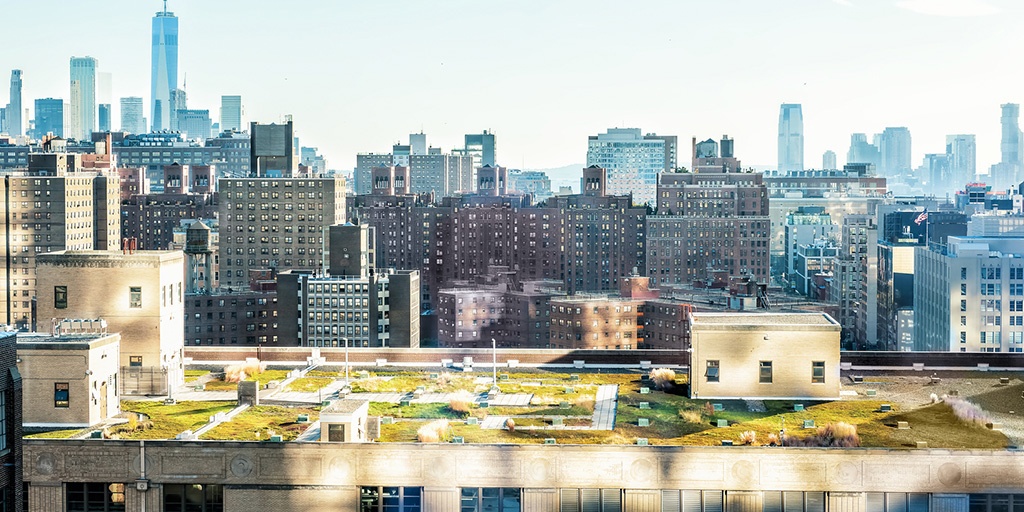There’s no debate that new construction and building demolition can take its toll on the planet. Construction has been labeled one of the top emitting sectors for greenhouse gases; for example, the EPA estimates that the construction industry generated 534 million tons of landfill debris in 2014 alone.
This is why many of us in the design and construction industry are increasingly focused on adaptive reuse, a rehabilitation technique that maintains the character and structure of a building. Adaptive reuse also utilizes as many interior materials and components as possible, while reimagining it as a modern, flexible building that fits today’s (and tomorrow’s) needs.
You can read more about the environmental impact of new construction vs. adaptive reuse in one of our previous articles. This article focuses on how adaptive reuse is taking advantage of innovative green design trends to create stronger, smarter buildings for our future.
Buildings Are Going Green (Literally)
Today’s adaptive reuse and other design projects are increasingly taking advantage of the benefits nature provides when integrated into an urban landscape. Though city planners during the early 1900s understood that green spaces were required to promote human happiness and a feeling of community, they didn’t realize that plants, trees, and bushes don’t have to be trapped in parks to do us good. We now know that livings plants can also be woven into the very fabric of architectural planning and design in the form of green walls and green roofs.
- Green Walls are living plant walls inside buildings that are being increasingly used to enhance insulation, provide solar protection, improve air and water filtration, and even provide better workspaces and living quarters.
- Green Roofs are finding their place in urban landscapes to help manage storm water (they’re very popular in Washington, D.C.), reduce noise and air pollution, mitigate the urban heat islands, and even restore and support endangered ecosystems, such as the honeybees. To learn more about green roofs, check out the Insights article highlighting a few stunning installations in New York City.
The current trends of green walls and green roofs are especially well-suited for adaptive reuse projects, since many of these types of projects are community-centric, mixed-use buildings. However, many cutting-edge architects are going even greener by using renewable energies and enhancing their designs with biomimetic architecture.
Design Professionals Are Treating the Building’s “End of Life” as Their Beginning Stages
New construction projects are typically still the critical part of any architect’s focus. New buildings can get in on the reuse action as well with flexibly built structures that serve multiple uses over time and integrate new technologies and layouts throughout their decades.
Design professionals, who ensure that they’re planning for a building’s “end” of life by leaving it adaptable for its next great adventure, focus on creating easy-to-update spaces. These often include post-and-beam interior architecture, removable partition walls, movable sprinklers, ducts, and air diffusers, and simple-access electrical and plumbing. Design professionals also focus on using long-lasting, eco-friendly materials that not only serve many functions and lifetimes within the building they were originally placed in, but also in other buildings.
Today’s Designers Are Focusing on Our Industry’s Fun, Sustainable Future
Though many design professionals view adaptive reuse solely as reclaiming derelict buildings, there’s actually a lot more to it than that – and the range of possibility in these projects make them highly sustainable, eco-friendly, and fun.
For example, in addition to repurposing old buildings and helping them achieve new life, adaptive reuse can also focus on repurposing old materials and components from other buildings. If you take reclaimed wood from one aging building and then add painted, corrugated steel from another aging building, you can combine these elements into fresh, exciting, new interiors in a third building that’s not only sustainable, but also 100% unique. (And, as we all know, unique buildings tend to draw crowds!)
Design professionals new to adaptive reuse sometimes overlook the fact that these projects can turn the entire world into a single, fascinating puzzle to be mixed and matched, put together and taken apart in endless variations. The possibilities are only limited by each architect’s imagination.
Today’s top green design trend for adaptive reuse is to break down boundaries and test all the limits. If plants can be used for insulation, old building materials can be used for decoration, and new buildings can actively encourage their own deconstruction. What other possibilities are just over the horizon?
Get insight into the latest trends, news, and updates for architects with the Milrose Insights blog. Subscribe today so you can get the best of the blog in your inbox on demand.








